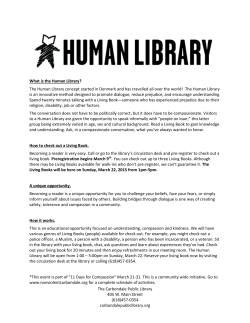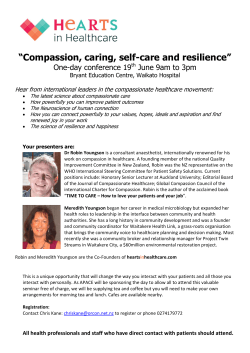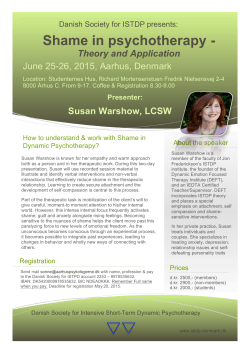
presentation as a PDF - Linda Graham, MFT, Resources
Troubled Youth Conference, Utah May 7, 2015 Linda Graham, MFT linda@lindagraham-mft.net www.lindagraham-mft.net Connections Increasing the social connections in our lives is probably the single easiest way to enhance our well-being. - Matthew Lieberman, UCLA Linda Graham, MFT Marriage and Family Therapist – 25 years Bouncing Back: Rewiring Your Brain for Maximum Resilience and Well-Being 2013 Books for a Better Life award 2014 Better Books for a Better World award www.lindagraham-mft.net linda@lindagraham-mft.net There are no mistakes when there is learning. - Julia Butterfly Hill The brain learns from experience People can learn to respond differently To manage stress To bounce back from adversity People can choose new experiences that Create new coping strategies Rewire old coping strategies People can strengthen their response flexibility To recover their resilience and well-being Resilience for Students Manage impulses, appropriate behavior Curiosity, openness to learning and change Process-encode information into memory Use information creatively and productively Imagine, think, plan Navigate social world, social intelligence Empathic interactions with others Develop identity, core values, moral compass Contribute to larger community, world Premise of Catalyzing Brain Change Different neural activities underlie Different levels of brain functioning, thus Different mechanisms of brain change Four mechanisms of brain change to address Four levels of student functioning Incremental Skills to Quantum Learning When overwhelmed, stressed, survivor of trauma Restore baseline calm, presence, equilibrium When stuck in negative, defensive patterns Antidote negativity bias; install more resilient strategies When de-railed by shame Rewire toxic shame and inner critic; recover secure base When open to learning Expand to intuition, imagination, creativity, flow, flourishing of authentic self Modern Brain Science Neuroscience technology is 25 years old The field of neuroscience is so new, we must be comfortable not only venturing into the unknown but into error. - Richard Mendius, M.D. Neuroscience of Brain Change Mindfulness meditation improves attention and impulse control; students get better grades, higher SAT scores; schools have less violence, less bullying Oxytocin (neurostransmitter of safety and trust) can calm a panic attack in less than a minute Kindness and comfort protects against stress, trauma, psychopathology - lifelong Neuroplasticity Greatest discovery of modern neuroscience Growing new neurons Strengthening synaptic connections Myelinating pathways – faster processing Creating and altering brain structure and circuitry Organizing and re-organizing functions of brain structures The brain changes itself - lifelong Evolutionary legacy Genetic templates Family of origin conditioning Norms-expectations of society Who we are and how we cope… …is not our fault Given neuroplasticity and choices of self-directed neuroplasticity Who we are and how we cope… …is our responsibility - Paul Gilbert,PhD, The Compassionate Mind The brain is shaped by experience. And because we have a choice about what experiences we want to use to shape our brain, we have a responsibility to choose the experiences that will shape the brain toward the wise and the wholesome. - Richard J. Davidson, PhD Mechanisms of Brain Change Conditioning New Conditioning Re-Conditioning De-Conditioning Conditioning Experience causes neurons to fire Repeated experiences, repeated neural firings Neurons that fire together wire together Strengthen synaptic connections Connections stabilize into neural pathways Without conscious intervention, is what happens in the brain all the time Conditioning is neutral, wires positive and negative Conditioning – Skills and Functions How brain learns from experience Encodes learning, behaviors, skills in neural circuitry Develops pre-frontal cortex Strengthens inner secure base, personal sense of self Professional relationship = re-parenting Attachment Styles - Secure Parenting is attuned, empathic, responsive, comforting, soothing, helpful Attachment develops safety and trust, and inner secure base Stable and flexible focus and functioning Open to learning inner secure base provides buffer against stress, trauma, and psychopathology Insecure-Avoidant Parenting is indifferent, neglectful, or critical, rejecting Attachment is compulsively self-reliant Stable, but not flexible Focus on self or world, not others or emotions Rigid, defensive, not open to learning Neural cement Insecure-Anxious Parenting is inconsistent, unpredictable Attachment is compulsive caregiving Flexible, but not stable Focus on other, not on self-world, Less able to retain learning Neural swamp Disorganized Parenting is frightening or abusive, or parent is “checked out,” not “there” Attachment is fright without solution Lack of focus Moments of dissociation Compartmentalization of trauma Pre-Frontal Cortex Development kindled in relationships Executive center of higher brain Evolved most recently – makes us human Matures the latest – 25 years of age Most integrative structure of brain Evolutionary masterpiece CEO of resilience Pre-Frontal Cortex - Functions Regulate body and nervous system Quell fear response of amygdala Manage emotions Attunement – felt sense of feelings Empathy – making sense of experience Insight and self-knowing Response flexibility Planning, decision making True Other to the True Self The roots of resilience are to be found in the felt sense of being held in the mind and heart of an empathic, attuned, and self-possessed other. - Diana Fosha, PhD To see and be seen: that is the question, and that is the answer. - Ken Benau, PhD New Conditioning Choose new experiences Gratitude practice, listening skills, focusing attention, self-compassion, self-acceptance Create new learning, new memory Encode new wiring “Little and often”; install new pattern of response Cues to Practice - ANTS to PATS Identify habitual negative pattern of response Identify new, positive response to counter/replace Identify cue word or phrase to name negative and positive Criticism - Compassion Use cue to break automaticity and change the channel Repeat the practice as many times as necessary Re-conditioning Memory de-consolidation – re-consolidation “Light up” neural networks Juxtapose old negative with new positive Neurons fall apart, rewire New rewires old Re-conditioning Resource with memory of someone’s compassion toward you Evoke compassion for your self Evoke memory of someone being critical of you (or inner critic) Hold awareness of criticizing moment and compassionate moment in dual awareness Drop the criticizing moment; rest in the compassionate moment Modes of Processing Focused Tasks and details New conditioning and re-conditioning De-focused Default network Mental play space De-conditioning De-Conditioning Default network De-focusing, loosens grip Creates mental play space Can open to worry, rumination Can open to plane of open possibilities Brain makes new links, associations New insights, new behaviors De-Conditioning Imagination Guided visualizations Guided meditations Reverie, daydreams Brain “plays,” makes own associations and links, connect dots in new ways Reflect on new insights Compassionate Friend Sit comfortably; hand on heart for loving awareness Imagine safe place Imagine warm, compassionate figure – Compassionate Friend Sit-walk-talk with compassionate friend Discuss difficulties; listen for exactly what you need to hear from compassionate friend Receive object of remembrance from friend Reflect-savor intuitive wisdom Practices to Accelerate Brain Change Presence – primes receptivity of brain Intention/choice – activates plasticity Practice – creates new pathways, new more resilient habits of coping Perseverance – installs change Catalyzing Brain Change When in overwhelm, stress, trauma NEW conditioning: new experiences restore calm, equilibrium When stuck in negative, defensive patterns NEW conditioning: antidote negativity bias, install new more resilient coping strategies When overwhelmed by shame RE-conditioning: recover inner secure base When open to learning DE-conditioning: expand to intuition and imagination Intelligences When in overwhelm, stress, trauma SOMATIC intelligence: body-based skills of calm and compassion When stuck in negative, defensive patterns EMOTIONAL intelligence: heart-based skills of positive emotions, curiosity, optimism When de-railed by shame RELATIONAL intelligence: skills to heal heartache, access support and resources, navigate peopled world When open to learning: REFLECTIVE intelligence: catch the moment, make a choice; dream and soar 6 C’s of Coping Calm Compassion Clarity Connections to Resources Competence Courage Calm Manage disruptive emotions Tolerate distress Down-regulate stress to return to baseline equilibrium Calm through the Body Hand on the Heart Touch/Hugs Body Scan Progressive Muscle Relaxation Power Posing Mindfulness and Compassion Awareness of what’s happening (and our reactions to what’s happening) Acceptance of what’s happening (and our reactions to what’s happening) Two most powerful agents of brain change known to science; both foster response flexibility Rewiring that is safe, efficient, effective Mindfulness and Compassion Activate Caregiving System Mindfulness Focuses awareness on experience May I accept this moment, exactly as it is Self-Compassion Focuses kindness on experiencer May I accept myself exactly as I am in this moment Activates caregiving system Shift from reactivity and contraction to openness, engagement Self-Compassion Break Notice moment of suffering Ouch! This hurts! This is painful. Soothing touch (hand on heart, cheek, hug) Kindness toward experiencer May I be kind to myself in this moment May I accept this moment exactly as it is May I accept myself in this moment exactly as I am May I give myself all the compassion I need to respond to this moment wisely One for Me; One for You Breathing in, “nourishing, nourishing” Breathing out, “soothing, soothing” In imagination, “nourishing for me, nourishing for you, soothing for me, soothing for you” “One for me, one for you” Practice breathing “one for me, one for you” when in conversation with someone Caregiving with Equanimity Everyone is on his or her own life journey. I am not the cause of this person’s suffering, nor is it entirely within my power to make it go away, even if I wish I could. Moments like this are difficult to bear, Yet I may still try to help if I can. Emotional Intelligence Perceiving, identifying, managing one’s own emotional landscape with openness and curiosity Regulating negative emotions Cultivating positive emotions Maintaining emotional vitality and equilibrium Recognizing others’ emotions, empathizing with emotional causes of behaviors Responding to one’s own and others’ emotions skillfully and compassionately Positive Emotions Gratitude Awe Generosity Compassion Delight Serenity Love Curiosity Kindness Joy Trust Negativity Bias – Left Shift Brain hard-wired to notice and remember negative and intense more than positive and subtle; how we survive as individuals and as a species Leads to tendency to avoid experience Positive emotions activate “left shift,” brain is more open to approaching experience, learning, and action Positive Emotions Less stress, anxiety, depression, loneliness More friendships, social support, collaboration Shift in perspectives, more optimism More creativity, productivity Better health, better sleep Live on average 7-9 years longer Resilience is direct outcome A hundred times every day, I remind myself that my inner and outer life depend on the labors of other people, and that I must exert myself in order to give in the same measure as I have received and am still receiving. - Albert Einstein Gratitude 2-minute free write Gratitude journal Gratitude buddy Carry love and appreciation in your wallet Take in the Good Notice: in the moment or in memory Enrich: felt sense in the body Absorb: savor 10-20-30 seconds Repeat: 6 times a day; install in long-term memory True Other to the True Self The roots of resilience are to be found in the felt sense of being held in the mind and heart of an empathic, attuned, and self-possessed other. - Diana Fosha, PhD To see and be seen: that is the question, and that is the answer. - Ken Benau, PhD Deep Listening The most basic and powerful way to connect to another person is to listen. Just listen. Perhaps the most important thing we ever give each other is our attention….A loving silence often has far more power to heal and to connect than the most well-intentioned words. - Rachel Naomi Remen, M.D. Resonance Circuit Resonance – vibe, emotional contagion Attunement – felt sense, explicit, non-verbal Empathy – verbal, cognitive, coherent narrative Compassion – concern, caring, help Acceptance – pre-requisite for resilience and lasting change Neuroscience of empathy Dyadic regulation Social engagement system Vagal brake Fusiform gyrus regulates amygdala Restores equilibrium See Yourself as Others See You Imagine sitting across from someone who loves you unconditionally Imagine switching places with them; see yourself as they see you; feel why they love you and delight in you; take in the good Imagine being yourself again; taking in the love and affection coming to you; savor and absorb. The Guest House - Rumi This being human is a guest-house. Every morning a new arrival. A joy, a depression, a meanness, Some momentary awareness come As an unexpected visitor. Welcome and entertain them all! Even if they’re a crowd of sorrows, who violently sweep your house empty of its furniture, still, treat each guest honorably. He may be clearing you out for some new delight. The dark thought, the shame, the malice, meet them at the door laughing, and invite them in. Be grateful for whoever comes, because each has been sent as a guide from beyond. - Rumi Reconditioning of Shame that De-Rails Resilience Shame is the intensely painful feeling or experience of believing we are flawed and therefore unworthy of acceptance and belonging. Shame erodes the part of ourselves that believes we are capable of change. We cannot change and grow when we are in shame, and we can’t use shame to change ourselves or others. - Brene Brown, PhD Just that action of paying attention to ourselves, that I care enough about myself, that I am worthy enough to pay attention to, starts to unlock some of those deep beliefs of unworthiness at a deeper level in the brain. - Elisha Goldstein Reconditioning Memory de-consolidation – re-consolidation “Light up” neural networks of problematic memory Cause neural networks to fall apart temporarily and instantly rewire by: Juxtaposing positive memory that directly contradicts or disconfirms; Focused attention on juxtaposition of both memories held in simultaneous dual awareness Causes the falling apart and the rewiring Reconditioning Anchor in present moment awareness Resource with acceptance and goodness Start with small negative memory “Light up the networks” Evoke positive memory that contradicts or disconfirms Simultaneous dual awareness (or toggle) Refresh and strengthen positive Let go of negative Rest in, savor positive Reflect on shifts in perspective Wished for Outcome Evoke memory of what did happen Imagine new behaviors, new players, new resolution Hold new outcome in awareness, strengthening and refreshing Notice shift in perspective of experience, of self Relational Intelligence Receiving/reaching out for help Setting limits and boundaries Negotiating change Repairing ruptures Forgiveness Receiving-Reaching Out for Help Identifying conditioned patterns Avoiding/rejecting; clinging Practicing the opposite pattern Asking/receiving; activating/experimenting Allowing the new pattern to settle in Self-compassion when new practice is difficult; evokes shame Setting Limits and Boundaries Identify values that determine limit Create context of mindful empathy Assert limits/boundaries State consequences Enforce consequences Negotiating Change Speaker requests dialogue Speaker/listener create conditions to be heard Speaker states topic sentence Speaker uses “I” statements; focuses on own perceptions, reactions, needs Listener reflects back; no interruptions, questions, defenses, explanations, judgments, criticisms Negotiationg Change, part 2 Listener summarizes; speaker corrects Speaker identifies 3 behavior he/she can do to meet identified need and 3 behaviors partner can do to meet identified need; positive, measurable, within time frame Each chooses one behavior to do in time frame Each acknowledges the other when behavior is done Repairing Ruptures Acknowledge existence of rupture; desire to repair Each states own experience, hurts, needs Each listens to and empathizes with experience, hurts, needs of other Each takes responsibility for their actions and acknowledges impact Each asks and offers forgiveness Forgiveness Forgiving ourselves Asking others for forgiveness Forgiving others for harm, hurt, betrayal, abandonment out of fear, anger, hurt, confusion in thought, word, or deed knowingly or unknowingly De-conditioning - Quantum Learning Insights Epiphanies Revelations Aha!s Therapeutic break-throughs Defocused mode Dreams Daydreams, reveries Stream of consciousness Imagination Guided visualization Imagination is more important than knowledge. For while knowledge defines all that we currently know and understand, imagination points to all we might yet discover and create. - Albert Einstein The intuitive mind is a sacred gift and the rational mind is a faithful servant. We have created a society that honors the servant and has forgotten the gift. - Albert Einstein Wiser Self Imagine yourself five years from now: wise, compassionate, good, strong, alive and vibrant Ask this Wiser Self: how did you become like this? What did you have to overcome or let go of to become like this? What one word of advice do you have for me? Inhabit this Wiser Self briefly; what does it feel like to become your Wiser Self? Welcome Them All Wiser Self welcomes to the “party” characters that embody positive and negative parts of the self with curiosity and acceptance of the message or gift of each part and honors each part of the “inner committee” Human Brain: Evolutionary Masterpiece 100 billion neurons Each neuron contains the entire human genome Neurons “fire” hundreds of time per second Neurons connect to 5,000-7,000 other neurons Trillions of synaptic connections As many connections in single cubic centimeter of brain tissue as stars in Milky Way galaxy How to Replenish Human Brain Exercise-Movement Sleep - Rest Nutrition Laughter-Play Learn Something New Hang Out with Healthy Brains Exercise - Movement Macro cardio – BDNF Yoga, qi gong – move the energy Micro 3-minute better than nothing workout Move your body once every hour Sense and savor walk Sleep - Rest Macro – 8 hours every night Housekeeping Reset nervous system Consolidate learning Sleep hygiene Micro Take mental breaks; switch the channel Take a nap Mini-meditate (10 breaths) Take Mental Breaks Focus on something else (positive is good) Talk to someone else (resonant is good) Move-walk somewhere else (nature is good) Every 90 minutes; avoid adrenal fatigue Nutrition Macro Eat healthy! More protein, more water, less sugar, less carbs, less calories, less caffeine/alcohol Micro Savor (eat a raisin meditation) Eat one meal a day without doing anything else Laughter-Play Macro Have a good time at family/friends dinner/celebration Schedule a play date Schedule a silly date Micro Watch a 4-minute Happify Daily video Read two minutes of jokes Learn Something New Macro Speak a foreign language Play a musical instrument Juggle Play chess Micro Learn a new poem, quote, flower, bird each day Hang Out with Healthy Brains Macro Friendships, extra-curricular activities and clubs, athletics, choir Practice gratitude at family dinners Micro Read 10 pages of a good book, magazine article, blog post Send the link of the above to a friend Send a text or email of gratitude, acknowledgement, appreciation to friend, co-worker Connections Increasing the social connections in our lives is probably the single easiest way to enhance our well-being. - Matthew Lieberman, UCLA Linda Graham, MFT www.lindagraham-mft.net linda@lindagraham-mft.net
© Copyright 2025









